When one thinks of American Indian reservations in Connecticut, the casino-fueled wealth of the Mashantucket Pequot and Mohegan tribes offer sterling examples of business success stories. But the situation is strikingly different at the Cheyenne River Sioux Tribe Reservation in La Plant, South Dakota, where poverty and unemployment levels are among the most acute in the nation.

“The poverty is worse than most Third World countries,” said Jody Bortone, associate dean of Sacred Heart University”™s (SHU) College of Health Professions and an associate professor of occupational therapy, who observed how “generations of abuse, genocide and trauma” have battered a geographically and economically isolated population.
Once a year for the past five years, SHU”™s nursing and occupational therapy students have spent a week at the reservation as part of a program coordinated with Simply Smiles, a Bridgeport-based nonprofit. The students work at a school and a clinic on the reservation and at a tribal hospital located in Eagle Butte.
“The mission of the university is the commitment to serve the human community, especially the poor,” added Bortone, who piloted this program with Linda Strong, an associate professor and director of community partnerships. “It is very important for students to engage with a variety of people.”
One of the most striking aspects of the Cheyenne River Sioux Tribe Reservation, at least from a Fairfield County perspective, is the vastness of land coupled with the relative scarcity of people living there.
“There is wide open prairie grass as far as the eye can see,” said Bryan Nurnberger, founder and president of Simply Smiles. “The reservation is about the size of Connecticut, but whereas Connecticut has 3.7 million people, the reservation has 9,000. And it is the most impoverished place in the country.”
Bortone added that the reservation”™s remoteness contributes to the health problems that plague its residents.
“The hospital at Eagle Butte is 36 miles way,” she explained. “While that doesn”™t sound like much, there are no gas stations in the town we”™re going to. And Eagle Butte is not a full-service hospital ”” you would either go to Pierre, which is one-and-a-half hours away, or Rapid City, which is four hours away. If there is an emergency call, you have at least a half-hour wait before help arrives.”
During the last SHU-Simply Smiles trip to the reservation in October, the occupational therapy students worked with teachers and students, observing the treatment of children with disabilities while offering teachers updates on lesson planning and student recreation. The nursing students volunteered at local walk-in clinics and saw first-hand the medical and mental health issues that are prevalent on the reservation.
“There are four local clinics that provide medical care,” Nurnberger said, adding that the nursing students focus on the most serious health issues at the reservation including diabetes and nutritional deficiencies.
And although the SHU students were guests at the reservation, their guest rooms were a far cry from Fairfield County housing.
“Our accommodations are extremely primitive,” Bortone recalled. “We had unheated barracks, latrines and no showers. And in October, it is not warm. But the students who elected to go tend to be very resilient and flexible and they reacted very positively.”





















